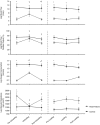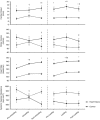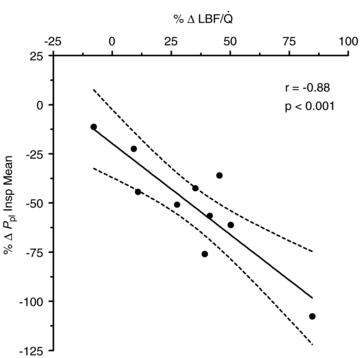Effects of respiratory muscle work on blood flow distribution during exercise in heart failure
- PMID: 20457736
- PMCID: PMC2915522
- DOI: 10.1113/jphysiol.2009.186056
Effects of respiratory muscle work on blood flow distribution during exercise in heart failure
Abstract
Heart failure (HF) patients have a reduced cardiac reserve and increased work of breathing. Increased locomotor muscle blood flow demand may result in competition between respiratory and locomotor vascular beds. We hypothesized that HF patients would demonstrate improved locomotor blood flow with respiratory muscle unloading during activity. Ten patients (ejection fraction = 31 +/- 3%) and 10 controls (CTL) underwent two cycling sessions (60% peak work). Session 1 (S1): 5 min of normal breathing (NB), 5 min respiratory muscle unloading with a ventilator, and 5 min of NB. Session 2 (S2): 5 min NB, 5 min of respiratory muscle loading with inspiratory resistance, and 5 min of NB. Measurements included: leg blood flow (LBF, thermodilution), cardiac output (Q), and oesophageal pressure (P(pl), index of pleural pressure). S1: P(pl) was reduced in both groups (HF: 73 +/- 8%; CTL: 60 +/- 13%, P < 0.01). HF: Q increased (9.6 +/- 0.4 vs. 11.3 +/- 0.8 l min(-1), P < 0.05) and LBF increased (4.8 +/- 0.8 vs. 7.3 +/- 1.1 l min(-1), P < 0.01); CTL: no changes in Q (14.7 +/- 1.0 vs. 14.8 +/- 1.6 l min(-1)) or LBF (10.9 +/- 1.8 vs. 10.3 +/- 1.7 l min(-1)). S2: P(pl) increased in both groups (HF: 172 +/- 16%, CTL: 220 +/- 40%, P < 0.01). HF: no change was observed in Q(10.0 +/- 0.4 vs. 10.3 +/- 0.8 l min(-1)) or LBF (5.0 +/- 0.6 vs. 4.7 +/- 0.5 l min(-1)); CTL: increased (15.4 +/- 1.4 vs. 16.9 +/- 1.5 l min(-1), P < 0.01) and LBF remained unchanged (10.7 +/- 1.5 vs. 10.3 +/- 1.8 l min(-1)). These data suggest HF patients preferentially steal blood flow from locomotor muscles to accommodate the work of breathing during activity. Further, HF patients are unable to vasoconstrict locomotor vascular beds beyond NB when presented with a respiratory load.
Figures





Comment in
-
Cardiorespiratory responses to exercise in CHF: a conspiracy of maladaptation.J Physiol. 2010 Aug 1;588(Pt 15):2683. doi: 10.1113/jphysiol.2010.193805. J Physiol. 2010. PMID: 20675813 Free PMC article. No abstract available.
Similar articles
-
Cardiorespiratory responses to exercise in CHF: a conspiracy of maladaptation.J Physiol. 2010 Aug 1;588(Pt 15):2683. doi: 10.1113/jphysiol.2010.193805. J Physiol. 2010. PMID: 20675813 Free PMC article. No abstract available.
-
Respiratory muscle work influences locomotor convective and diffusive oxygen transport in human heart failure during exercise.Physiol Rep. 2020 Jun;8(12):e14484. doi: 10.14814/phy2.14484. Physiol Rep. 2020. PMID: 32562374 Free PMC article.
-
Respiratory muscle work compromises leg blood flow during maximal exercise.J Appl Physiol (1985). 1997 May;82(5):1573-83. doi: 10.1152/jappl.1997.82.5.1573. J Appl Physiol (1985). 1997. PMID: 9134907
-
Effect of skeletal muscle demand on cardiovascular function.Med Sci Sports Exerc. 2000 Jan;32(1):94-9. doi: 10.1097/00005768-200001000-00015. Med Sci Sports Exerc. 2000. PMID: 10647535 Review.
-
The hyperpnoea of exercise in health: Respiratory influences on neurovascular control.Exp Physiol. 2020 Dec;105(12):1984-1989. doi: 10.1113/EP088103. Epub 2020 Mar 16. Exp Physiol. 2020. PMID: 32034952 Review.
Cited by
-
Regulation of increased blood flow (hyperemia) to muscles during exercise: a hierarchy of competing physiological needs.Physiol Rev. 2015 Apr;95(2):549-601. doi: 10.1152/physrev.00035.2013. Physiol Rev. 2015. PMID: 25834232 Free PMC article. Review.
-
Inspiratory muscle weakness in cardiovascular diseases: Implications for cardiac rehabilitation.Prog Cardiovasc Dis. 2022 Jan-Feb;70:49-57. doi: 10.1016/j.pcad.2021.10.002. Epub 2021 Oct 22. Prog Cardiovasc Dis. 2022. PMID: 34688670 Free PMC article. Review.
-
Short period of high-intensity inspiratory muscle training improves inspiratory muscle strength in patients with chronic kidney disease on hemodialysis: a randomized controlled trial.Braz J Phys Ther. 2020 May-Jun;24(3):280-286. doi: 10.1016/j.bjpt.2019.04.003. Epub 2019 May 6. Braz J Phys Ther. 2020. PMID: 31122717 Free PMC article.
-
Dietary nitrate supplementation opposes the elevated diaphragm blood flow in chronic heart failure during submaximal exercise.Respir Physiol Neurobiol. 2018 Jan;247:140-145. doi: 10.1016/j.resp.2017.09.017. Epub 2017 Oct 14. Respir Physiol Neurobiol. 2018. PMID: 29037770 Free PMC article.
-
NAD(P)H oxidase subunit p47phox is elevated, and p47phox knockout prevents diaphragm contractile dysfunction in heart failure.Am J Physiol Lung Cell Mol Physiol. 2015 Sep 1;309(5):L497-505. doi: 10.1152/ajplung.00176.2015. Epub 2015 Jul 24. Am J Physiol Lung Cell Mol Physiol. 2015. PMID: 26209274 Free PMC article.
References
-
- Aaron EA, Seow KC, Johnson BD, Dempsey JA. Oxygen cost of exercise hyperpnea: implications for performance. J Appl Physiol. 1992;72:1818–1825. - PubMed
-
- Beck KC, Hyatt RE, Mpougas P, Scanlon PD. Evaluation of pulmonary resistance and maximal expiratory flow measurements during exercise in humans. J Appl Physiol. 1999;86:1388–1395. - PubMed
-
- Borghi-Silva A, Carrascosa C, Oliveira CC, Barroco AC, Berton DC, Vilaca D, Lira-Filho EB, Ribeiro D, Nery LE, Neder JA. Effects of respiratory muscle unloading on leg muscle oxygenation and blood volume during high-intensity exercise in chronic heart failure. Am J Physiol Heart Circ Physiol. 2008;294:H2465–H2472. - PubMed
Publication types
MeSH terms
Grants and funding
LinkOut - more resources
Full Text Sources
Other Literature Sources
Medical
Research Materials
Miscellaneous

